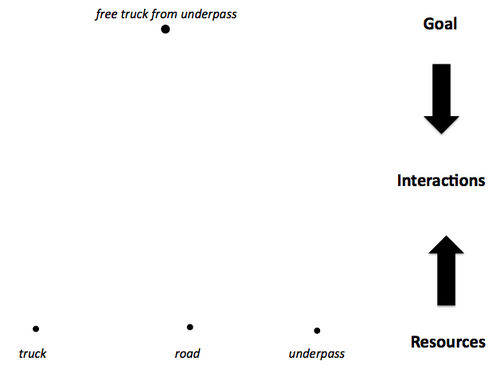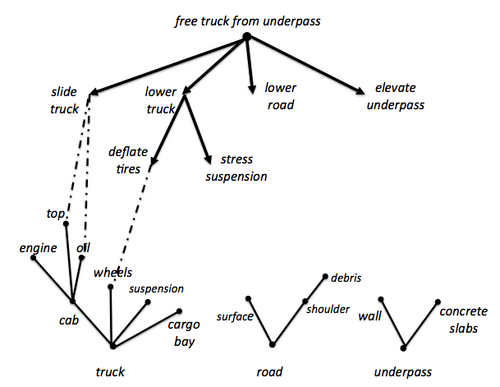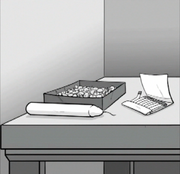Game Designer / Creator[]
- Created by Tony McCaffrey, PhD, Cognitive Psychology, UMass Amherst

Figure 1: Starting Graph for the Stuck Truck Problem

Figure 2: Two Solutions for the Stuck Truck Problem
Game Summary[]
Youth can learn the new group problem solving process Brainswarming and have fun solving problems together.
Brainstorming doesn’t work well—although it has been the go-to method since 1953. Every experiment done has shown that brainstorming does not produce more ideas than having people generate ideas alone and then come together to share them and build on them. Certain social dynamics hinder brainstorming: (1) talkative people tend to dominate the quieter people even if you have a skilled facilitator and (2) a power differential between boss and employees (or teacher and students) can curb contributions by the less powerful group.
Here’s a radical thought: Why do we need to talk when ideating together? Swarms of insects solve problems by leaving traces in their environment that influence the behavior of the other members (i.e., stigmergy). Humans could quietly leave Post-It notes and string (or drawn lines) on a dynamically growing problem-solving graph for others to build upon.
For example, how can you free a UPS truck after an inattentive driver got the truck stuck beneath an underpass? As in Figure 1, simply put the goal at the top and a few known resources at the bottom. Then instruct the group not to talk but simply add Post-It notes and string as they contribute sub-goals growing downward, parts of resources growing upwards (or new resources), and effects of interacting resources in the middle. In a brief session, a pilot group quickly and quietly created seven solutions as indicated by where the two directions hook up in Figure 2. Only two of the seven solutions are shown here: (1) deflating the tires and (2) lubricating the top of the truck.
One solution is to deflate each of the tires enough so that the truck decreases in height by a few inches. This will lower the truck and it should be able to drive away to a gas station to refill the tires. The Brainswarming diagram is very minimal in the information it presents, so if this is not clear from the diagram the student who created the solution should write it out in more detail at a different part of the blackboard. For the other solution shown in Figure 2, the goal of sliding the truck was achieved by putting oil from the truck engine on the top of the truck to make it slippery. If people do not know how to remove oil from the truck engine, then this could become a new problem for a new Brainswarming diagram.
Players / Moderators[]
- Ages 10 and up.
- About 10 students can work comfortably on one Brainswarming graph. If you have more students, set up multiple Brainswarming graphs at different parts of the room and have the groups compete with each other to devise the most solutions to the problem.
- Need one moderator to initially teach the Brainswarming method and keep the graph orderly as the youth contribute to it.
Game Set-up and Construction[]
Just need a black/whiteboard to write on. Often, I use stick Post-It notes on a blackboard and draw lines between the related notes.
You also need what are called “insight puzzles” for your group to work on. These are puzzles that require an aha moment before the solution becomes clear. Often these puzzles have more than one solution. At the end of this document, I have listed a standard set of insight puzzles. Also, my research group continually makes up new insight puzzles, so we can be a source of puzzles for those teachers who want to use them with their youth.
No cost!
How to Play / Game Rules[]
- Moderator chooses an insight puzzle and initiates the Brainswarming graph on the board (similar to Figure 1). Moderator writes the goal at the top and the known resources at the bottom.
- Moderator explains the insight puzzle to the group (e.g., Stuck Truck Problem).
- Moderator explains (or reminds) the group how Brainswarming works. Here are the main points to cover. No talking is necessary among the group while Brainswarming is going on. Simply write your contribution on a Post-It note (or on the board) and draw a line to what it should be connected to. There are three types of contributions you could make. First, you could break a resource into one of its parts. In this case, put your Post-It note just above the resource and draw a line to the resource. Second, you could make a goal more specific. For example, the top goal in Figure 2, free truck from underpass, is very general. Ask yourself, “How could I achieve this goal?” One way is to lower the truck, so this sub-goal should go below the goal free truck from underpass. In general, ask yourself the How question to make goals more specific and concrete. Third, you could add an interaction such as put oil from the truck engine on the top of the truck so the truck will slide more easily. On the Brainswarming diagram, this interaction is indicated very simply by adding lines that connect oil, the truck top, and slide the truck. If the interaction is not clear to people, the contributor can write it in more detail on a different part of the blackboard so as to not clutter up the Brainswarming diagram.
- Depending on the materials available, moderator makes Post-It notes and pens available or just several pieces of chalk.
- Scoring: Students get 1 point for each contribution they make to the Brainswarming graph. A student receives 5 points if they propose a possible solution (i.e., their contribution to the graph connects the upper and lower parts of the graph). Also, a student gets 3 points if their contribution becomes part of a solution—even if they didn’t actually notice the solution themselves. By this scoring method, a student who makes many contributions can outscore a student who solves the problem. This emphasizes that contributing is important and highly-valued! Someone else might build upon your contribution and go on to solve the problem even if you yourself did not solve the problem. We want to reward making helpful contributions!
Templates / Diagrams[]
- See above
Related Web Links[]
- NA
Other Details[]
Brainswarming as a game illustrates how group problem solving can take place without all the downsides that hinder brainstorming.
Excitedly, Brainswarming scales up to work for remote groups working online at different times of the day or night. Companies are starting to use online Brainswarming and it is sure to spread and become even more popular. Workers don’t have to work simultaneously on the problem. Simply initialize an online Brainswarming graph with a goal at the top and a few known resources at the bottom and inform your colleagues around the world that the Brainswarming graph is ready for their contributions. Wake up the next morning to see what contributions and solutions came from your colleagues in Paris, for example. Brainswarming will become the go-to method to use for group problem solving—both in-person and online. Your students can become proficient in this new method and have fun doing it.
Below are several insight puzzles to get you started with your students. Again, my research lab continually creates new insight puzzles so we are a rich resource for future puzzles.
Two Rings Problem

Two Rings Problem
- You need to connect two rings together in the configuration in the diagram below so that when you grab the top ring and lift it up, the bottom ring will follow and remain securely fastened. Each ring weighs 3 pounds, is 6 inches in diameter, and is made of solid steel. You do not want to damage them. You have a long, thin candle, one long wooden match that will light almost anywhere, and a 2-inch cubic block of steel. How can you connect the two rings?
Escape the Tower Problem
- You are locked in a room with a window that is at the top of a tower that is 100 feet tall. You have a 60 foot rope. How can you escape the tower without severely injuring yourself by falling the final 40 feet?
Candle Problem

Candle Problem
- Sitting on a table are a candle, a box of tacks, and a book of matches. You must attach the candle to the wall so that it can burn upright and won’t drip wax onto the table. How would you solve the problem?
Wristwatch Problem
- You own a wristwatch with a leather band. You are in an empty room and you need to open the battery case on the back of the watch, which is secured with a small screw. You do not want to damage the watch. Your fingernail is not strong enough to turn the screw. How do you do it?
Hot Coals Problem
- You need to transport a dozen hot coals from a campfire site to another campfire site some 100 yards away. The coals are much too hot to touch and they will quickly burn through any cloth they come in contact with. You are walking home from basketball practice in your bare feet so you are carrying a basketball and your jersey on a metal hanger. How can you quickly transport all the coals at once before they cool?
Desk Lamp Problem
- For some bizarre reason, a desk lamp is screwed to the wall by its base. You need to remove the lamp from the wall without damaging either the wall or the lamp. The room is empty, except for you—and your pockets are empty. You cannot leave the room and no one can bring you anything. How can you remove the lamp from the wall?
Electrical Circuit Problem

Electrical Circuit Problem
- You need to connect the line of electricity from an electrical source to an electrical target, as shown in the diagram below. One 3-inch wire is fused to the electrical source. Another 3-inch wire is fused to the electrical target. The ends of the wires were screwed into a wooden table in your workshop by a screwdriver, which you still possess. You are missing the 3-inch wire that should connect the two screws. You also have a plastic ruler and a metal thumb tack, but have access to nothing else. How can you bridge the gap between the two screws so that when the electrical source is activated the electricity will flow to the target?
The Sock Problem
- Two blind men walk into the same store at the same time on a hot summer day and with some help from a salesperson each one gets two pairs of white socks and two pairs of black socks. The two men arrive at the checkout counter at the same time and the cashier, so surprised by this event, puts all the socks into one bag, giving it to one man while giving the other man an empty bag. Outside the two blind men discover what happened and all by themselves with no help from anyone else they sort the socks so that each man now has two pairs of white socks and two pairs of black socks. How did they do it?
